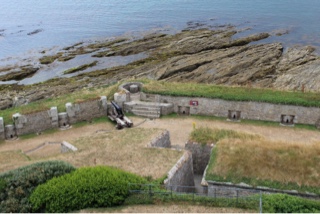Falmouth is a relatively new town, but the River Fal goes up to the city of Truro. It wasn't until the threat of invasion in 1538 that Henry VIII ordered the building of artillery forts to guard the coast including the Carrick Roads, which had become an important base for privateering. Both positions were upgraded, including land defences, during the Elizabethan conflict with Spain. A Spanish plan to capture Pendennis in 1597, caused the government to strengthen the castle and its garrison.
The defences were not tested until the English Civil War. Falmouth was an important port for the King and his fleet. After the Royalist defeat at Bovey Heath in March 1646, St Mawes was captured and Pendennis besieged. The defences were too strong to be assaulted and the garrison only surrendered when their supplies ran out.
The castles became somewhat dilapidated in the 18th century, but were repaired during the American War and then the Napoleonic wars. Pendennis became an important supply depot for Wellington's army in the Peninsular.
A further period of decline ended at the close of the 19th century with the installation of modern artillery. By 1888, the castles had breach loading guns and a submarine minefield also defended the entrance to the 'defended port' status that Falmouth gained.
In WW1, Falmouth yet again became an important supply port, but other than the sinking of a German submarine off Falmouth in September 1915, it saw no action. In 1940, Falmouth was in the front line of coastal defences against a German invasion and new six inch guns were installed, together with quick firing 6pdrs. German MTB's were the main target, although the port suffered from air raids.
The army left the castles in 1956, and they are now cared for, very well, by English Heritage.











My great grandfather was CO of the naval dockyard in Falmouth in the 1920's and my uncle was the police sergeant in St Mawes in the late 60's. I always loved visiting Pendennis Castle when I was a kid.
ReplyDelete